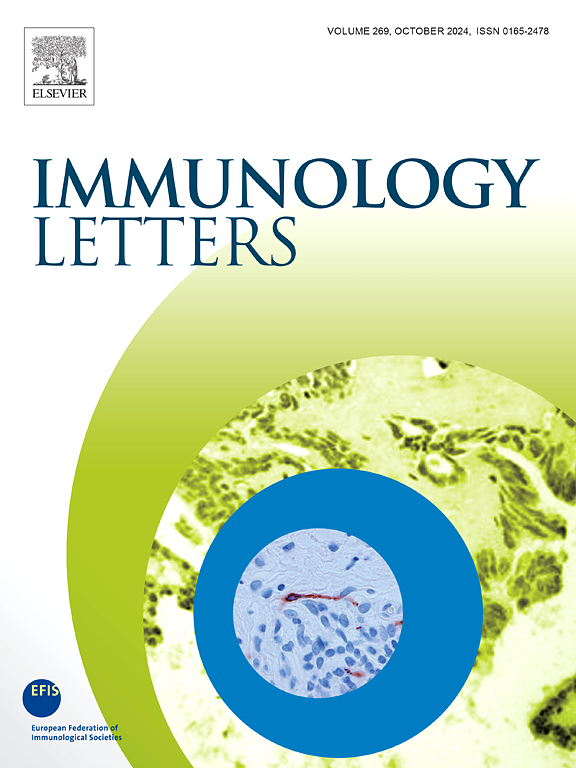1型糖尿病先天抗病毒免疫途径的遗传和转录失调
IF 2.8
4区 医学
Q3 IMMUNOLOGY
引用次数: 0
摘要
先天抗病毒免疫途径(InAIPs)在1型糖尿病(T1D)患者胰岛中失调,暗示肠病毒可能有助于β细胞自身免疫。然而,尚不清楚类似的失调是否发生在肠道中,从而导致屏障功能障碍等病理。因此,我们使用已发表的全基因组关联研究来鉴定肠通透性和InAIP基因的多态性。我们通过基因芯片分析比较了雌性糖尿病前期非肥胖糖尿病(NOD)和C57BL/6小鼠及其空肠上皮RNA谱。通过测量肠Caco-2细胞在R837 toll样受体7刺激下的跨上皮电阻,评估InAIP基因失调与肠通透性增加之间的潜在联系。肠通透性基因间存在T1D的遗传易感性。然而,InAIP基因包含更多有希望的t1d相关多态性,特别是TNFA、OAS3、PIGR、CD55、NOD2和IFIH1。将糖尿病前期NOD与C57BL/6小鼠进行比较,发现空肠中多个InAIP基因(Ifih1, Rnase1等)的年龄依赖性失调。最后,用R837刺激Caco-2细胞模拟肠道病毒感染,增加肠道通透性。我们证明了T1D中InAIPs的遗传和转录失调及其可能参与肠道屏障功能障碍,为肠道病毒感染的疾病表现机制提供了新的线索。本文章由计算机程序翻译,如有差异,请以英文原文为准。
Genetic and transcriptional dysregulation of innate antiviral immune pathways in type 1 diabetes
Innate antiviral immune pathways (InAIPs) are dysregulated in islets of type 1 diabetes (T1D) patients, implying how enterovirus might contribute to beta-cell autoimmunity. However, it is unclear whether similar dysregulation occurs in the intestine, contributing to pathologies like barrier dysfunction. Thus, we used a published genome-wide association study to identify polymorphisms in intestinal permeability and InAIP genes. We compared female prediabetic non-obese diabetic (NOD) and C57BL/6 mice and their jejunal epithelial RNA profile by GeneChip analysis. The potential link between dysregulation of InAIP genes and increased intestinal permeability was assessed by measuring trans-epithelial electrical resistance in intestinal Caco-2 cells upon R837 toll-like receptor 7 stimulation. There was genetic predisposition to T1D among intestinal permeability genes. However, InAIP genes contained more promising T1D-associated polymorphisms, especially for TNFA, OAS3, PIGR, CD55, NOD2, and IFIH1. Comparing prediabetic NOD with C57BL/6 mice revealed age-dependent dysregulation of several InAIP genes (Ifih1, Rnase1 etc.) in jejunum. Lastly, mimicking an enterovirus infection with R837 stimulation of Caco-2 cells increased intestinal permeability. We demonstrate genetic and transcriptional dysregulation of InAIPs in T1D and their potential involvement in intestinal barrier dysfunction, providing new clues to the disease-manifesting mechanisms of enterovirus infection.
求助全文
通过发布文献求助,成功后即可免费获取论文全文。
去求助
来源期刊

Immunology letters
医学-免疫学
CiteScore
7.60
自引率
0.00%
发文量
86
审稿时长
44 days
期刊介绍:
Immunology Letters provides a vehicle for the speedy publication of experimental papers, (mini)Reviews and Letters to the Editor addressing all aspects of molecular and cellular immunology. The essential criteria for publication will be clarity, experimental soundness and novelty. Results contradictory to current accepted thinking or ideas divergent from actual dogmas will be considered for publication provided that they are based on solid experimental findings.
Preference will be given to papers of immediate importance to other investigators, either by their experimental data, new ideas or new methodology. Scientific correspondence to the Editor-in-Chief related to the published papers may also be accepted provided that they are short and scientifically relevant to the papers mentioned, in order to provide a continuing forum for discussion.
 求助内容:
求助内容: 应助结果提醒方式:
应助结果提醒方式:


